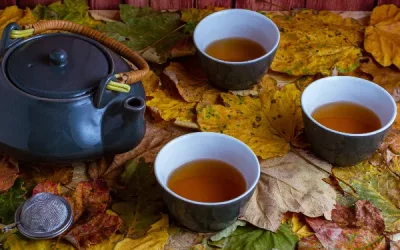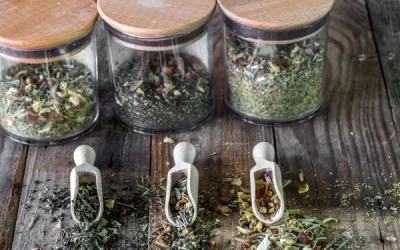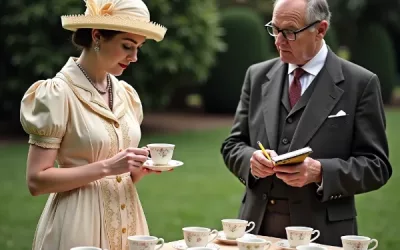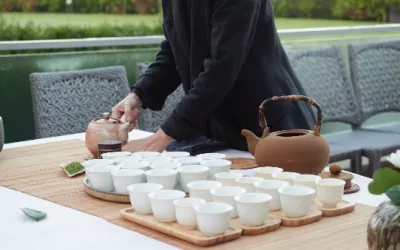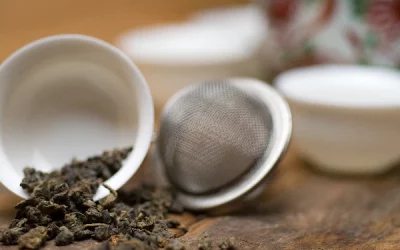Did you know that a simple cup of tea can host an intricate universe of flavours and aromas? For tea enthusiasts and casual drinkers alike, mastering the art of tea tasting not only enhances your drinking experience but also deepens your appreciation of this beloved beverage. In this guide, we’ll delve into key features of tea tasting, share structured methods to host tastings at home, and explore the fascinating similarities between tea and wine. Join us on this journey to elevate your tea knowledge and skills—let’s sip and savour!
Table of Content
- What are the key features to consider when tasting tea?
- How can I conduct a structured tea tasting at home?
- What are the common flavour profiles of different tea types?
- How does brewing method impact tea taste?
- Can tea tasting be compared to wine tasting?
- What tools can enhance the tea tasting experience?
- How can I improve my tea tasting skills?
- What are common misconceptions about tea tasting?
- Conclusion
What are the key features to consider when tasting tea?
When it comes to tea tasting, it’s not just about sipping and swallowing. You need to engage all your senses to truly appreciate the nuances of each brew. The key features to focus on are appearance, aroma, flavour, and mouthfeel. These elements work together to create a holistic tea-tasting experience.
By examining the appearance, you can gauge the quality and condition of the tea leaves. Aroma plays a pivotal role as it significantly influences how we perceive flavours. Flavour notes in tea can range from floral and fruity to earthy and nutty, making each cup a complex experience. Mouthfeel, which describes how the tea feels in your mouth, can vary from light and airy to thick and creamy.
How does the appearance of tea leaves affect perception?
The appearance of tea leaves gives you a first impression of what to expect. The colour, shape, and size of the leaves can tell you a lot about the tea’s quality and how it has been processed. For instance, whole leaves often indicate a higher quality tea compared to broken or dust-like leaves.
- Colour: Bright and vibrant leaves often indicate freshness.
- Shape: Uniform and unbroken leaves suggest meticulous handling.
- Size: Larger leaves usually point to better quality tea.
- Texture: Smooth and well-rolled leaves signal proper processing.
When you pour hot water over these leaves, their appearance can transform, offering more clues. A high-quality tea will unfurl beautifully, releasing its aroma and flavour.
Why is aroma crucial in tea tasting?
Aroma is incredibly important in tea tasting because it significantly influences your overall perception of flavour. Your sense of smell is closely linked to your sense of taste, so what you smell can greatly affect what you taste.
- First Impression: The initial whiff can set the stage for the entire tasting experience.
- Depth: Complex teas often have layers of aroma that can include floral, fruity, or earthy notes.
- Memory: Aroma can trigger memories and emotions, enhancing your enjoyment.
- Indicators: Strong or subtle aromas can indicate the tea’s freshness and quality.
By inhaling the aroma before sipping, you prepare your palate for the flavours to come. The scent can give you a preview of the tea’s complexity and richness.
What are the different flavour notes in tea?
Tea offers a wide range of flavour notes, making each tasting session unique. Understanding these notes helps you appreciate the complexity and depth of different teas.
- Floral: Jasmine, rose, and chamomile are common floral notes.
- Fruity: Citrus, berries, and stone fruits can be detected in many teas.
- Earthy: Notes like moss, wood, and even leather add depth.
- Nutty: Almond, hazelnut, and chestnut flavours often appear.
- Spicy: Some teas have hints of cinnamon, clove, or pepper.
Identifying these flavour notes can be a fun challenge. As you develop your palate, you’ll start to recognise and appreciate the intricate layers that each tea offers.
Tea tasting has a rich history, with many fascinating stories. For example, in ancient China, tea tasting was elevated to an art form during the Tang Dynasty. Scholars and poets would gather in tea houses, not just to drink tea, but to savour its essence and discuss its merits. It was a time when tea was more than a beverage; it was a cultural experience that brought people together.
How can I conduct a structured tea tasting at home?
Conducting a structured tea tasting at home can be a delightful and educational experience. Whether you’re a seasoned tea enthusiast or just beginning your journey, you can follow these steps to enhance your appreciation of different teas. To get started, gather a variety of teas, some basic equipment, and prepare to explore the diverse world of tea flavours.
A structured tea tasting involves brewing different types of tea, observing their unique characteristics, and comparing their flavours. Here’s a helpful table to guide you through the process. This table outlines various types of tea, recommended brewing times, ideal water temperatures, and common flavour profiles. Use this information to ensure you brew your tea correctly and fully appreciate its unique taste.
| Tea Type | Brewing Time | Water Temperature | Flavour Profile |
|---|---|---|---|
| Green Tea | 2-3 minutes | 75-85°C | Fresh, grassy, slightly sweet |
| Black Tea | 3-5 minutes | 95-100°C | Bold, malty, sometimes fruity |
| Oolong Tea | 3-4 minutes | 85-90°C | Floral, fragrant, complex |
| White Tea | 4-5 minutes | 75-80°C | Delicate, sweet, mild |
| Herbal Tea | 5-7 minutes | 95-100°C | Fruity, floral, herbal |
| Pu-erh Tea | 4-5 minutes | 95-100°C | Earthy, rich, sometimes sweet |
| Matcha | Whisk, no steep | 70-80°C | Umami, vegetal, creamy |
| Yellow Tea | 3-4 minutes | 75-80°C | Mild, sweet, sometimes nutty |
Use this table as a reference while you prepare your teas. Start by heating water to the appropriate temperature for each type of tea. Measure the right amount of tea leaves and steep them for the suggested time. Pay attention to the flavours, aromas, and colours of each tea as you taste them.
How do I prepare for a tea tasting?
Preparing for a tea tasting involves gathering the necessary equipment and setting up a comfortable tasting environment.
- Gather Your Equipment:
- Teapot or gaiwan (for steeping)
- Kettle (for boiling water)
- Timer (to ensure accurate steeping times)
- Small cups (for tasting)
- Notebook and pen (for taking notes)
- Set Up Your Tasting Area:
- Choose a clean, quiet space with good lighting.
- Arrange your teas and equipment neatly.
- Have a glass of water or neutral crackers to cleanse your palate between tastings.
- Select Your Teas:
- Choose a variety of tea types from the table above.
- Aim for 4-6 different teas to compare.
- Prepare Your Water:
- Use fresh, filtered water for the best taste.
- Heat the water to the recommended temperatures for each tea.
What should I look for during a tea tasting?
During a tea tasting, observe several key characteristics to fully appreciate the tea’s qualities.
- Aroma:
- Smell the dry leaves before brewing.
- Inhale the aroma of the brewed tea.
- Appearance:
- Observe the colour and clarity of the liquid.
- Examine the shape and colour of the wet leaves.
- Flavour:
- Take small sips and let the tea cover your tongue.
- Note the initial taste, body, and aftertaste.
- Mouthfeel:
- Pay attention to the texture of the tea in your mouth.
- Notice if it feels smooth, astringent, or creamy.
- Aftertaste:
- Observe the lingering flavour after swallowing.
- Consider how long the aftertaste lasts and its nature.
By focusing on these aspects, you’ll develop a deeper understanding of different teas and their distinct characteristics.
In the 18th century, Catherine of Braganza popularised tea in England. When she married Charles II, she brought her Portuguese customs, including tea drinking. Her love for tea influenced the British court and eventually the general public, leading to tea’s widespread popularity across Britain. This historical connection adds a rich layer to our tea drinking experience today.
Once, I hosted a tea tasting party for a few friends. We gathered various teas from different regions. We followed the steps above, and it turned into an evening of laughter, learning, and flavourful discoveries. Everyone left with a newfound appreciation for this ancient beverage, and I felt a deeper connection to the world of tea.
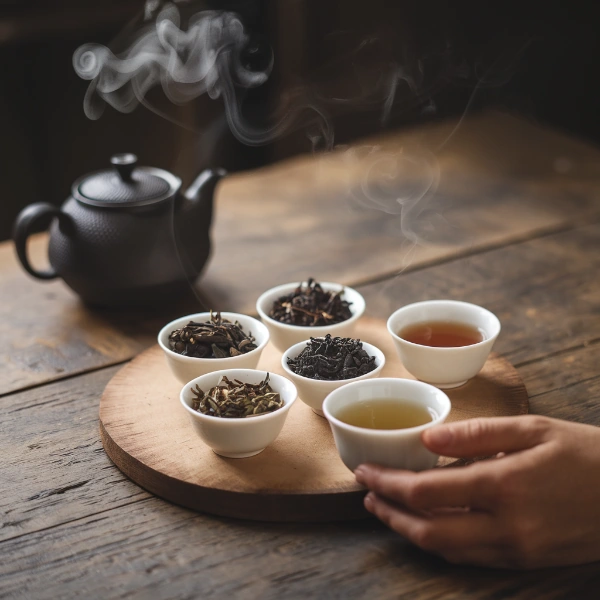
What are the common flavour profiles of different tea types?
Tea enthusiasts and casual drinkers often marvel at the breadth of tea flavours. From bold blacks to delicate whites, each variety presents a unique experience. The magic lies in the characteristics of each tea type, how they are processed, and the role of terroir in shaping their taste.
Different tea types, such as black, green, white, oolong, and herbal, each have their own distinctive profiles. Let’s dig into these delightful differences and uncover what each type has to offer.
How do black and green teas differ in taste?
Black and green teas couldn’t be more different. Black tea, known for its robust and often malty flavour, gives you that comforting, strong taste. Green tea, on the other hand, offers a lighter, more refreshing taste, typically vegetal or grassy.
Black teas can be described as bold and rich with:
- Malty undertones.
- Notes of caramel.
- Hints of dark chocolate.
- Floral or fruity notes, depending on the region.
Green teas, which hold back the oxidation process, often evoke:
- Grassy or vegetal flavours.
- Astringent and slightly sweet tones.
- Hints of seaweed or toasted rice.
- Subtle floral or nutty notes.
So, if you’re after something with a punch, go black. If you prefer something light and fresh, green tea is your best friend.
What flavour notes are typical in oolong tea?
Oolong tea is like the love child of black and green teas, sitting comfortably in the middle of the oxidation spectrum. This produces a variety of flavour profiles depending on how it’s processed.
Typical oolong tea flavour notes include:
- Toasty and nutty undertones.
- Floral aromatics like orchids or lilacs.
- Sweet stone fruit, such as peach or apricot.
- Creamy or buttery textures.
To sum it up, oolong tea is a complex and versatile brew, perfect if you crave a bit of everything.
How does the processing method influence tea flavour?
The method used to process tea leaves fundamentally alters their flavour. Each step in the process – from withering to firing – impacts the eventual taste.
Processing methods influence tea flavour in the following ways:
- Oxidation: Increases richness and depth, like in black teas.
- Firing: Adds baked or toasty notes, which can be found in some green and oolong teas.
- Rolling: Releases aromatic compounds, contributing to flavour complexity.
- Fermentation: Develops unique profiles, seen in pu-erh teas.
Each processing method not only differentiates one type of tea from another but also creates an opportunity for various flavours within the same type of tea, making tea tasting an adventurous journey every time.
Back in the 1820s, Robert Fortune, a Scottish botanist, set out for China to learn the secrets of tea production. Disguised as a Chinese merchant, he toured tea production areas and smuggled tea plants and seeds to India. This clandestine operation greatly influenced the establishment of tea plantations in Darjeeling and Assam, revolutionising the British tea industry. Thanks to Fortune’s espionage, today we have a rich variety of tea tastes available right at our fingertips.
Enjoy your next cup, knowing each sip is a product of centuries of cultivation, innovation, and a hint of espionage!
How does brewing method impact tea taste?
Brewing tea isn’t rocket science, but it’s definitely an art. If you’ve ever wondered why your cuppa sometimes tastes like liquid gold and other times like pond water, the brewing method might be to blame. Let’s face it, brewing tea properly can make the difference between a soothing experience and wondering if you accidentally brewed twigs.
Good water quality, precise steeping time, and the right temperature are the holy trinity of tea brewing. These elements work in harmony to extract the best flavours from your tea leaves, and, let’s be real, we all want that perfect brew.
What is the ideal water temperature for different teas?
When it comes to brewing, not all teas are created equal. Different teas require different temperatures to bring out their best characteristics. Treat your teas like distinct personalities, each with its own quirks.
- Green Tea: 70-80°C. Too hot, and you’ll get the bitterness of a moody teenager.
- Black Tea: 90-100°C. Needs the heat to release its robust flavour, kinda like that morning espresso.
- White Tea: 80°C. Gentle and delicate, treat it like the sensitive artist it is.
- Oolong Tea: 85-90°C. Somewhere between green and black, it likes to keep things balanced.
- Herbal Tea: 95-100°C. Throw it in with boiling water; it can handle the heat.
Temperature affects extraction—too high, and you might over-extract the tannins and oils, resulting in bitterness. Too low, and you might as well drink warm water.
How does steeping time affect the taste of tea?
Time is money, and in tea brewing, time is flavour. Steeping too long or too short can dramatically alter your tea’s taste.
- Short Steeping (1-2 minutes): Light, subtle flavours and less caffeine. Ideal for a mild experience.
- Medium Steeping (3-4 minutes): Balanced flavour and aroma. This is your Goldilocks zone—just right.
- Long Steeping (5+ minutes): More robust flavour but can turn bitter. Great if you like your tea with a little punch to the throat.
Steeping time varies across different teas. Green tea and white tea need less time, while black tea and oolong can handle a bit more. Herbal teas, being the durable warriors they are, can steep for a long time without turning undrinkably bitter.
Why is water quality important in tea brewing?
Water. The silent hero of your tea experience. You could have the most exquisite, hand-picked, rare tea leaves but ruin it with poor water quality.
- Filtered Water: Removes impurities and chlorine, which can mess with the taste.
- Mineral Content: Too many minerals (hard water) can make the tea taste metallic. Too little (soft water), and it may lack depth.
- Spring Water: Often considered ideal, as it has a balanced mineral content.
Some say you’re 98% water; your tea is pretty much the same. Using high-quality water enhances the taste, aroma, and mouthfeel of your brew. Your tea leaves deserve it, and so do you.
Tea aficionados have long understood the alchemy of brewing. Take the Japanese tea ceremonies, for instance. These ancient rituals perfected the art of tea-making, with masters like Sen no Rikyū painstakingly selecting the best water from mountain springs and insisting on precise temperatures and times. Their dedication wasn’t just about the brew; it was a meditative practice celebrating the perfect union of water, leaves, and human touch.
So next time you brew, think of yourself as a modern-day tea master, crafting a harmonious balance in a cup.
Can tea tasting be compared to wine tasting?
Absolutely, tea tasting can be compared to wine tasting. Both practices involve a sophisticated level of sensory evaluation, focusing on the aroma, flavour, and even the appearance. Just as wine enthusiasts wax poetic about notes of cherry, leather, and tobacco, tea aficionados also dissect their sips into complex profiles that include everything from floral to earthy undertones.
Both experts in tea and wine tasting have to rely on their primary senses—smell and taste. However, the importance of aroma, looking for the telling characteristics of each beverage, and identifying the nuances in flavour profiles is critical in both disciplines. Let’s face it, whether you’re swirling tea or twirling wine, it’s all about sniffing, sipping, and sounding like you know what you’re talking about.
What are the main similarities between tea and wine tasting?
Tea tasting and wine tasting have a ton in common. For instance:
- Sensory Evaluation Techniques: Both require a keen sense of taste and smell, and a bit of a flair for the dramatic.
- Aroma Importance: The aroma plays a critical role in both, as it often sets the stage for what you’re about to experience.
- Complex Flavour Profiles: Just like wine, tea has a wide range of flavours including earthy, sweet, floral, and even spicy notes.
- Tasting Methods: In both fields, the liquid is swirled around in the mouth to discern its different layers, and yes, the slurping sound is a badge of honour.
- Descriptors and Notes: Tea tasting and wine tasting both use a plethora of descriptive terms that could easily be mistaken for a poetry reading.
Don’t be surprised if a cross-over happens one day and you find sommeliers debating the subtleties of a smoky Lapsang Souchong as passionately as they do Sauvignon Blanc.
How do aroma and flavour complexity compare?
Aroma and flavour complexity in tea and wine share many characteristics, but they do differ in some fascinating ways:
- Layering of Flavours: Both beverages can have unique layers of flavour that evolve over the course of the tasting. It’s like peeling an onion, one tear at a time.
- Aroma Development: The aroma in both tea and wine can change significantly with exposure to air, enhancing the complexity over time.
- Nose and Notes: In both, the initial smell (or ‘nose’) can radically differ from the taste. It’s a bit of a box of chocolates—always a surprise.
- Time and Aging: While wine can be aged for decades, most teas don’t age except for special varieties like Pu-erh tea which, like fine wine, actually improves with age.
- Ingredients and Terroir: The flavour complexity in both drinks is heavily influenced by where they are grown, the soil, and the climate—echoing the term “terroir” used primarily in the wine world.
Even though we’re comparing the intricacies of fermenting grapes to brewing leaves, the precision and care taken in evaluating these aromas and flavours make both experiences equally profound and enjoyable.
What unique aspects are specific to tea tasting?
Tea tasting isn’t just about refining your palate; it has its own unique quirks that you won’t find in the world of wine:
- Infusion Time: The brewing time can drastically alter the taste of tea, which means if you get distracted by your cat for just a minute too long, your perfect Darjeeling might turn into a bitter disappointment.
- Temperature Sensitivity: Different teas require water at different temperatures for optimal flavour extraction. What can I say? Tea’s a bit of a diva.
- Multiple Infusions: Quality teas often allow for multiple infusions, each revealing different aspects of the flavour profile.
- Varieties and Forms: Teas come in various forms such as loose leaf, powdered (matcha), and even compressed bricks. It’s like the Swiss Army knife of beverages.
- Cultural Elements: The process of tea tasting is deeply embedded in various cultures, from the Japanese tea ceremony to British afternoon tea, adding a rich layer of tradition.
Wine might have its châteaux and cellars, but tea has centuries-old ceremonies and an alarmingly large number of teapots.
One delightful historical tale to tickle your brain: the tale of Robert Fortune, a Scottish botanist and the ultimate tea spy. In the 1840s, Fortune was sent by the British East India Company to China to secretly obtain tea plants and smuggle them to India. Disguised as a Chinese merchant, Fortune managed to acquire and transport thousands of tea plants by ship—a feat that changed the tea industry forever. While his methods were less than ethical, his adventurous spirit surely brewed the birth of modern tea drinking outside China. So next time you sip your Darjeeling, remember that it has a sneaky Scotsman to thank for its presence in your cup!
What tools can enhance the tea tasting experience?
Tea tasting is like being a tea detective. You get to dive into a world of flavours, aromas, and a whole lot of enjoyment. But like any great detective, having the right tools makes the job a whole lot easier. Let’s take a peek into the toolbox that can give you the edge in identifying that hidden jasmine note or the elusive umami in your cuppa.
Now, you might think, “It’s just tea—pour hot water, steep, sip, done.” But if you want to get all Sherlock Holmes on your tea, you need a few extra gadgets and fancy terms. And by ‘gadgets,’ I mean everything from a tea tasting wheel, to proper teaware, and the humble but crucial note-taking method. Let’s break it down.
How can a tea tasting wheel assist in flavour identification?
A tea tasting wheel is like a cheat sheet for your taste buds. It’s a visual prompt that helps you name those elusive flavours dancing on your palate. Think of it as a colour wheel but for taste and aroma.
- Simplifies complex flavours: Breaking down the myriad of flavours into simple categories.
- Structure: Helps you systematically approach the tasting process.
- Reference tool: Great for comparing different teas.
- Confidence booster: Helps you put a name to what you’re tasting, rather than just saying, “It tastes… good, I think?”
- Insightful: Can reveal new dimensions in even familiar teas.
Without one, you might feel like you’re just shooting in the dark, guessing if that’s a hint of bergamot or just your imagination. With it, however, you have a structured approach to identify nuances like a seasoned veteran.
What types of teaware are best for tasting?
Not all cups are created equal, my friend. The vessel you use can seriously influence your tasting experience. Let’s look at a few that are worth adding to your collection.
- Gaiwan: Perfect for gongfu cha, offering control over steeping times.
- Yixing teapot: Great for oolongs and pu’erh, but remember, these pots “season” and take on the flavour of the tea.
- Porcelain cups: Neutral, thus not affecting the taste and letting every note shine through.
- Tasting cups and trays: Help keep the tasting process organised and professional.
- Strainers and filters: Essential for those who don’t enjoy a mouthful of leaves.
Choosing the right teaware isn’t just about being fancy; it influences how the tea tastes and how you experience it. Imagine sipping a delicate green tea from a heavy, rustic mug—not ideal. Instead, a light, elegant porcelain cup would elevate the experience.
Why is note-taking important during a tasting?
Note-taking during a tea tasting session may sound as exciting as watching paint dry, but trust me, it’s gold. Here’s why jotting down your thoughts can make you a true connoisseur:
- Builds a flavour database: Over time, you’ll have a comprehensive record of your tastes.
- Memory aid: Helps recall specific tea profiles when shopping or discussing teas.
- Improvement tool: Spot patterns and understand how different variables affect the taste.
- Communication: Share your insights with other tea enthusiasts.
- Comparison: Compare different teas side by side and understand their distinct features.
Grabbing a notebook and scribbling down notes might seem a bit old school, but it’s an invaluable practice for honing your taste skills. It makes each sip an educational experience, improving your understanding of tea one note at a time.
Tea tasting isn’t just for snobs with monocles. It’s a skill anyone can enjoy, and using the right tools makes it even better. Speaking of passion and tea, remember the story of Lu Yu. Known as the Sage of Tea, he wrote the first known treatise on tea, the “Cha Jing” or “The Classic of Tea,” in the 8th century. His meticulous observations and dedication transformed tea tasting into the refined art it is today. And it all started with a keen sense of observation—something you too can develop with the right tools.
How can I improve my tea tasting skills?
You love tea, right? You’re not alone. Improving your tea tasting skills isn’t as daunting as it sounds. It’s a bit like improving your taste in music; it takes regular practice, exploring new genres (or in this case, tea types), and maybe even joining a club of like-minded enthusiasts. Let’s jump into these practical tips so you can channel your inner tea connoisseur.
First off, get in the habit of regular practice. Like anything worth mastering—be it playing the guitar, perfecting a pancake flip, or even ninja-level tea tasting—consistency is key. Taste different teas, record your impressions, and compare notes over time.
Next, expand your horizons by exploring different tea types. There’s a world beyond your usual cup of Earl Grey or chamomile; trust me. Adventuring into unknown tea territories sharpens your tasting skills and broadens your palate.
Lastly, consider joining a tea tasting group. Surrounding yourself with fellow tea enthusiasts can do wonders. It’s like having a bunch of coaches who help you spot subtle notes you might miss on your own. Plus, it’s a bonus to geek out about tea in a judgment-free zone.
How often should I practise tea tasting?
The short answer? Often enough to keep your taste buds on their toes, but not so much that you start seeing teabags in your dreams. For most folks, a couple of times a week should do the trick. Here’s why:
- Consistency: It’s like brushing your teeth. Do it often enough, and it becomes second nature.
- Memory: Your taste memory improves, helping you to better recall and identify flavours.
- Discovery: Each session can reveal something new, even in teas you’ve tasted before.
- Mindfulness: Tasting regularly helps you focus on the moment, enhancing your enjoyment.
You don’t need a formal ceremony every time you sip. Keep it casual. Try to fit it into your routine. Maybe with breakfast, or as a wind-down in the evening (psst… herbal teas are great before bed).
What are the benefits of exploring various tea types?
Sipping the same tea every day is like only listening to one song on repeat. Diversifying your tea repertoire brings several perks to the table (pun intended).
- Enhanced Palate: Different teas expose your taste buds to a spectrum of flavours.
- Versatility: You’ll have a brew for every mood and occasion.
- Health Benefits: Different teas offer various antioxidants, vitamins, and minerals.
- Appreciation: Understanding the unique characteristics of each tea type deepens your appreciation for this ancient drink.
Dive into an Oolong one day, an Assam the next, maybe even a Pu-erh on a daring day. Each brings a unique profile, like how different wines offer diverse tasting experiences.
How can joining a tea group enhance my skills?
Ever heard the saying, “Two heads are better than one”? Well, multiple tea tasters are better than one too. Here’s what you gain from joining a tea group:
- Feedback: Instant and diverse opinions on your tasting notes.
- Learning: Seasoned tea lovers can offer tips and insights you won’t find in books.
- Exposure: Groups often share rare or unique teas you might not try otherwise.
- Motivation: Being part of a community keeps you engaged and motivated.
Think of it as joining a book club but tastier. You sip, you chat, you learn. It’s a tea party and a learning experience rolled into one.
In the late 1800s, English tea merchant Thomas Lipton astonished the world by making quality tea affordable, turning it from a luxury item into a common pleasure. He didn’t do this alone; he amassed knowledge from tea farmers, merchants, and enthusiasts, proving that talking about tea can lead to extraordinary things. Joining a tea group could be your stepping stone to tasting sophistication.
So, what are you waiting for? Grab your favourite mug, steep some leaves, and start practising. The world of tea is vast, intricate, and just waiting for you to explore.
What are common misconceptions about tea tasting?
Ah, tea tasting. It’s like wine tasting, but with fewer hangovers and more requisite pinky-raising. But with centuries of history and millions of fans worldwide, you’d think we’d have a handle on it by now. Yet, misconceptions and myths persist. Let’s nip those in the bud and spill some facts.
Tea tasting isn’t just for the elite tea masters who wear robes and chant mantras over their kettles. Anyone can enjoy it. Unfortunately, there are several myths that can dampen your tea-tasting fun. Those myths often revolve around tea quality, flavour profiles, and, surprisingly, your personal preferences.
What are some myths about high-quality tea?
Let’s start with myths that give posh sorts of tea a bad rap.
- Only expensive tea is good tea: Just because you took out a small loan to buy that tea doesn’t mean it will taste better.
- Tea bags are inferior: Snobs may scoff at these humble leaves housed in little pouches, but quality often depends on the producer, not the packaging.
- All green teas taste the same: Drinking a variety of green teas can feel like embarking on a flavour expedition.
- Older tea is always better: While aged Pu-erh might improve, others like green tea are best fresh.
- Organic tea tastes better: Organic doesn’t always mean better; a lot depends on the actual growing and processing methods.
Remember, tea’s charm often lies in its diversity. Sometimes, the cheapest tea can thrill your taste buds and make you question the need for luxury brands. Keep your mind (and teapot) open.
How do personal preferences influence tea tasting?
Personal preference is the king, queen, and Jester of tea tasting.
- Starts with flavour: Some folks swoon over floral notes, others find them gag-worthy.
- Temperature matters: Who knew that some people love scorching hot tea while others delight in a cooler brew?
- Caffeine tolerance: Your body’s tolerance can guide you towards delicate white teas or robust black ones.
- Cultural upbringing: The tea-drinking culture you’re raised in influences your tastes more than you may realise.
- Mood: Even your mood can alter how you perceive the tea’s taste.
There’s no “one-size-fits-all” in tea; it’s like a choose-your-own-adventure book. One person’s bitter swill is another’s ambrosia. So, don’t let anyone tell you you’re “wrong” for liking a certain type.
Why is it important to challenge misconceptions?
If we cling to stale beliefs, we miss out on a world of flavour and fun.
- Broadens horizons: Questioning myths opens you up to new and exciting teas.
- Empowerment: Knowledge is power, and understanding deeper nuances lets you savour every sip.
- Prevents snobbery: There’s no room for tea elitism. Your taste buds are the ultimate judges.
- Engages community: When you challenge misconceptions, you foster an inclusive tea-loving community.
- Improves experience: Knowing more helps you better appreciate and enjoy your tea sessions.
Misconceptions can sully a hobby that’s all about enjoyment and relaxation. Don’t merely accept popular myths; dig deeper and enjoy what you love without judgement or inhibition.
In the early 19th century, Anna Maria Russell, Duchess of Bedford, found herself grappling with hunger pangs during the long gap between lunch and dinner. This led her to the brilliant idea of “Afternoon Tea,” filling the void with tea and a snack. It became a fashionable social event in Britain, challenging the misconception that tea was only for the wealthy.
Now, Afternoon Tea is a beloved practice worldwide, proving that sometimes, questioning the norm can lead to delightful traditions.
So, next time you sip your tea, do so with the satisfaction of knowing you’re part of a long history of taste rebels. Cheers!
Conclusion
In reflecting on the intricate world of tea tasting, it’s clear that understanding its key features—appearance, aroma, flavour, and mouthfeel—settles the foundation for any tea enthusiast. Each of these elements contributes significantly to our overall perception and enjoyment of tea, transforming a simple beverage into a complex sensory experience.
The nuance brought by the visual beauty of the leaves and the fragrant aromas cannot be overstated; they are vital in shaping our anticipations and enhancing our tasting journeys.
As we’ve explored, conducting a structured tea tasting at home can be both informative and enjoyable. The structured table outlined in the article serves as a practical guide for anyone looking to delve deeper into their tea experience, offering insights into the optimal brewing conditions and flavour profiles associated with various tea types.
This method not only elevates the tasting experience but also empowers us to appreciate the distinctive characteristics of each cup.
The differences in flavour profiles among black, green, oolong, white, and herbal teas highlight the diversity this ancient beverage offers. It is crucial to recognise how processing methods and the terroir can affect the taste, allowing us to connect more intimately with our brew. Furthermore, understanding the relationship between brewing methods and tea taste can enhance our appreciation for this art form—good water quality, correct steeping times, and the right temperatures are all key players in this delicate balance.
Comparing tea tasting to wine tasting opened my eyes to the complexity and depth both practices share. While the nuances may vary, they both demand a meticulous attention to sensory details. We also discussed how tools, such as tea tasting wheels and proper teaware, can augment our tasting experience, reminding us that our journey in tea tasting doesn’t have to be solitary; engaging with others, through groups or discussions, can greatly enhance our skills and broaden our horizons.
Ultimately, it’s vital to challenge the common misconceptions that often cloud our understanding of tea. Personal preferences play a significant role in how we perceive flavour and quality, making it essential to cultivate an open mind and embrace the unique qualities that each tea brings to the table.
As I continue on my tea-tasting adventure, I invite you to consider your own palate and experiences. What if, the next time you brew a cup, you took a moment to reflect on the journey each sip offers? Perhaps this simple act could transform your appreciation for tea, evolving your experience from a daily ritual into a canvas for exploration and mindfulness. After all, in the words of a wise tea master, “Every cup of tea is an invitation to discover the world.” So, let’s steep ourselves in curiosity and sip towards mastery.
Resources
- Rituals, discourses, and realities: Serious wine and tea tasting in …
- The Analysis of Experimental Data: The Appreciation of Tea and Wine …
- Influence of Various Tea Utensils on Sensory and Chemical Quality of …
- The types of brewing water affect tea infusion flavor by changing the tea mineral dissolution
- Association between chemistry and taste of tea: A review
- Foods | Free Full-Text | Advances in Tea Chemistry – MDPI


